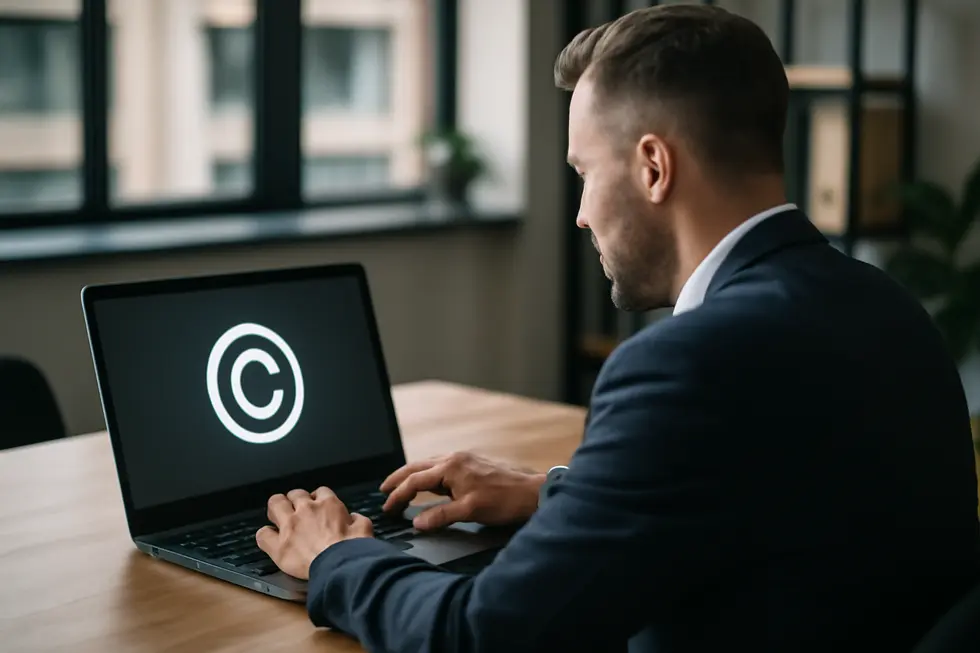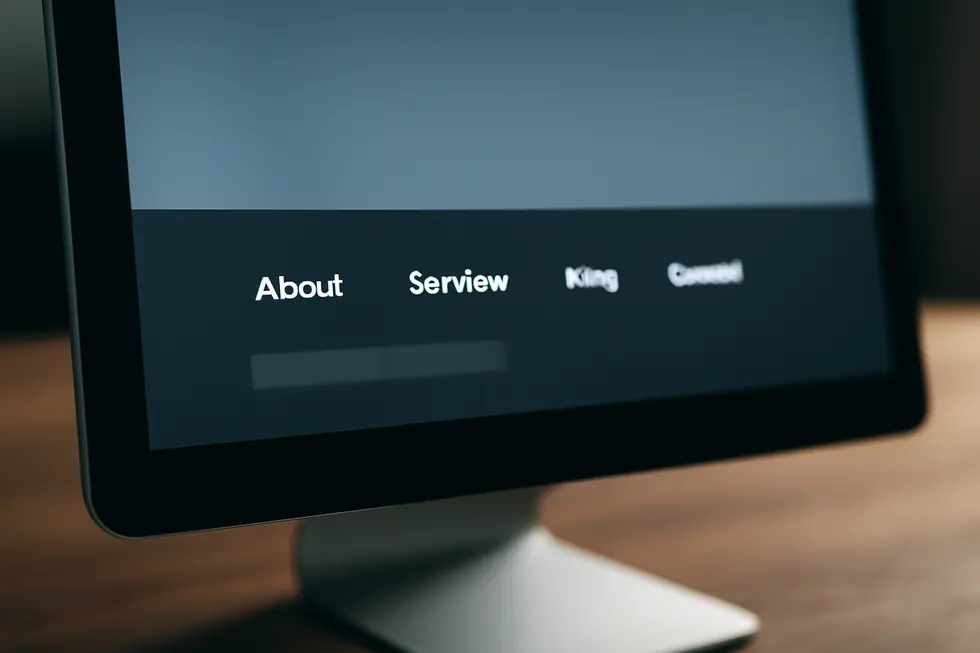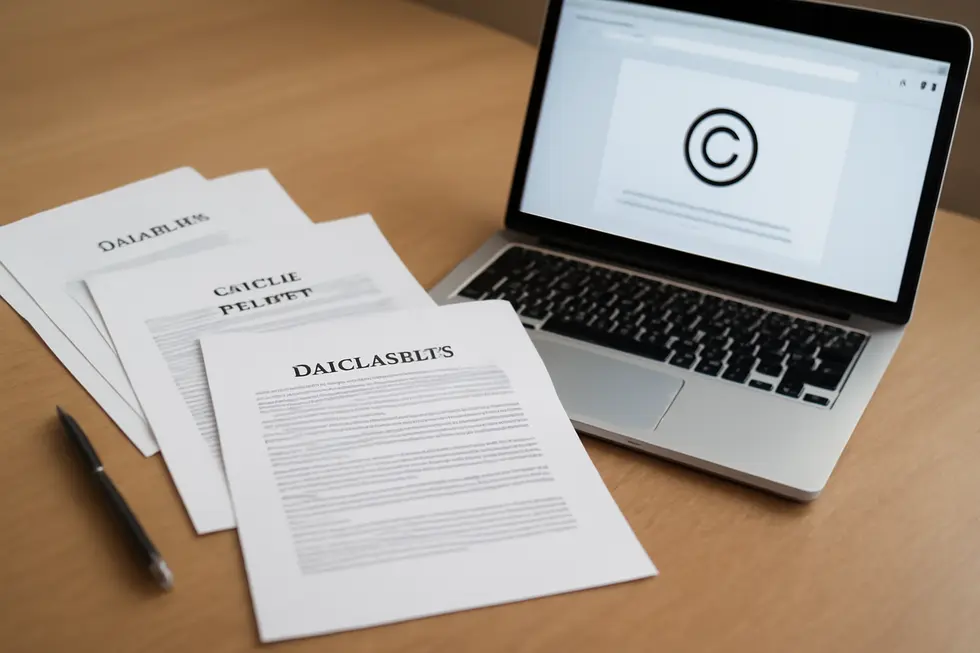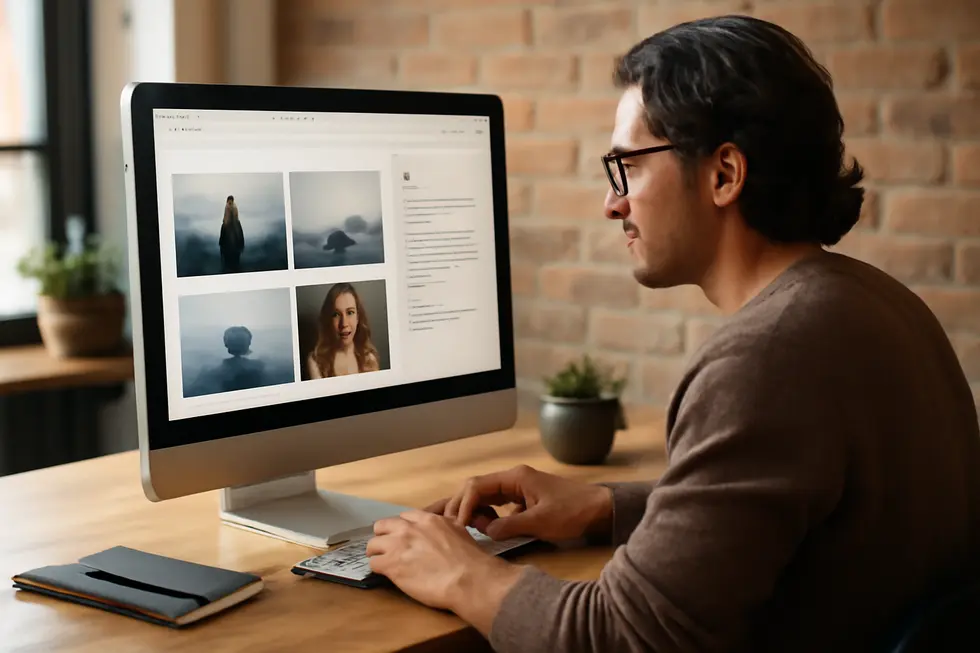Introduction
For business owners, protecting the intellectual property on your website is vital to maintaining your competitive edge and brand integrity. A well-crafted copyright message serves as a visible marker of ownership and a deterrent against unauthorized use. Understanding its importance, proper formatting, legal implications, and how it integrates with other legal agreements ensures your website content remains protected. This comprehensive guide explores the crucial role of copyright messages, explains their standard presentation and ideal placement on your website, and highlights complementary legal tools to reinforce your protections. It also shares practical examples and best practices, providing actionable strategies for business owners to confidently secure their online content and counter risks of infringement.
Tables of Contents
Chapter 1: Copyright Message Website: Importance and Legal Implications
- Digital Tools and Legal Signals: Enhancing Copyright Protection on Websites
- Economic Influence of Copyright Messages: Safeguarding Creative Revenue and Legal Rights
- Navigating Geopolitical Complexities in Website Copyright Messages
- How Website Copyright Messages Shape Legal Awareness and Digital Respect
Chapter 2: Standard Format and Placement of Copyright Message on Copyright Message Websites
- Optimizing Copyright Message Display: Technical Standards for Format, Placement, and Accessibility
- Economic Impact of Clear Copyright Notices: Enhancing Intellectual Property Value and Monetization
- Navigating International Legal Standards: How Geopolitical Laws Shape Copyright Message Formats and Placement on Websites
- Building User Trust and Enhancing Clarity Through Accessible Copyright Message Design
Chapter 3: Complementary Legal Agreements to Support Copyright Message Website Protections
- License Agreements: Defining Use and Control to Strengthen Website Copyright Protections
- Securing Ownership and Confidentiality: The Vital Role of NDAs and Work-for-Hire Agreements in Website Copyright Protection
- Strengthening Website Content Security Through Non-Compete and Non-Solicitation Agreements
- Strengthening Website Copyrights Through Terms of Service and Collaborative Enforcement
Chapter 4: Practical Examples and Best Practices for Implementing Copyright Message Website Notices
- Crafting Clear, Visible Copyright Notices to Protect Website Content Effectively
- Enhancing Website Protection: Legal Compliance and Efficient DMCA Takedown Processes
- Harnessing Technology and Strategy for Robust Copyright Messages on Websites
- Enhancing User Awareness and Transparency Through Effective Copyright Notices
Chapter 1: Copyright Message Website: Importance and Legal Implications

1. Digital Tools and Legal Signals: Enhancing Copyright Protection on Websites
Digital Tools and Legal Signals: Enhancing Copyright Protection on Websites
A copyright message on a website goes beyond mere formalities—it leverages technology to assert and support legal ownership. Typically composed of the © symbol, publication years, and the copyright holder’s name, this notice informs users that the content is legally protected. Although automatic upon creation, visibly embedding this message on each page, especially where original content appears, strengthens the owner’s position by negating claims of “innocent infringement” and potentially raising damages if unauthorized use occurs.
Technological integration extends this protection. Copyright notices in footers are complemented by embedding metadata and digital watermarks, which discreetly establish ownership without disrupting user experience. Further, sophisticated tools like digital rights management (DRM) systems and automated monitoring—via alerts or reverse image searches—help site owners detect unauthorized use proactively. When infringement is identified, mechanisms such as DMCA takedown notices facilitate prompt legal and platform responses, accelerating removal of illicit content.
These technological signals create a robust legal framework. Courts and platforms recognize visible and embedded copyrights as clear notices, often tipping the balance in enforcement actions. This is increasingly critical with new challenges posed by AI usage of copyrighted digital materials, emphasizing the necessity of clear, technologically supported copyright claims.
For deeper insights on digital copyright enforcement and legal strategies, refer to comprehensive copyright infringement risk guides available through expert resources.
2. Economic Influence of Copyright Messages: Safeguarding Creative Revenue and Legal Rights
Copyright messages on websites serve as a critical economic safeguard, underpinning creators’ and businesses’ ability to control and profit from their digital content. By clearly displaying ownership, these messages help secure exclusive rights that enable monetization methods such as licensing, sales, and advertising. For instance, software developers rely on copyright protection to maintain control over distribution, fostering innovation while generating income. Moreover, social media influencers and enterprises often face direct financial risks from copyright breaches, as repeated violations can lead to account suspensions and lost sponsorship opportunities, seriously impacting revenue and brand value.
Legally, copyright messages support enforcement mechanisms like DMCA takedown notices that remove unauthorized content, protecting ongoing business operations and deterring piracy. The evolving landscape, especially regarding AI-generated content, adds complexity as the legal system balances fair use with infringement concerns, influencing future monetization frameworks. Ultimately, these copyright claims preserve economic value by providing creators legal recourse against infringement and maintaining the integrity of markets tied to original works and trademarks. This integrated approach strengthens the financial ecosystem surrounding creative content, ensuring creators retain control and compensation. For more insights into the economic and legal facets of copyright, see copyright definition economics business.
3. Navigating Geopolitical Complexities in Website Copyright Messages
Navigating Geopolitical Complexities in Website Copyright Messages
The geopolitical landscape profoundly influences how copyright messages on websites are crafted and enforced. Diverse national copyright laws and data protection regulations, such as the EU’s GDPR and China’s PIPL, require website operators to tailor their copyright notices and compliance practices for each jurisdiction where their content is accessible. Geopolitical tensions further complicate this, sometimes restricting information access or disrupting enforcement mechanisms, as seen in conflicts that affect foreign participation and digital content flow.
This complexity forces businesses to embed geopolitical risk management in their intellectual property strategies, ensuring that their copyright messages reflect evolving legal climates and regional sensitivities. They must also include disclaimers and terms that clarify liability boundaries under various legal regimes. Rapid technological advances, like AI-driven content creation, intersect with these geopolitical factors, pushing continual updates in copyright law frameworks worldwide.
Integrating awareness of geopolitical risks enables website owners to safeguard their content globally and comply with shifting regulations. For more on the legal frameworks that underpin copyright protections, see copyright language for business owners.
External insights on the geopolitical impact on copyright enforcement can be found in recent analyses by international policy experts.
4. How Website Copyright Messages Shape Legal Awareness and Digital Respect
A copyright message on a website does more than assert ownership; it actively shapes societal behavior and legal perceptions around digital content. By clearly displaying the © symbol alongside the year and copyright holder’s name, websites communicate that their original content is protected under copyright law. This transparency discourages casual copying and distribution, fostering respect for creators’ intellectual property and encouraging users to seek permission before reuse. Although not mandatory in the U.S., such notices carry vital legal weight, strengthening infringement claims by negating innocent intent and clarifying whom to contact for licensing.
The legal implications extend further—the visible notice supports enforcement actions ranging from informal requests to DMCA takedown notices. These protections not only uphold creators’ rights but also preserve their economic incentives to innovate and produce quality content. On social media and digital platforms, copyright enforcement tied to notices can result in content removal, strikes, or suspensions, significantly affecting creators’ reputations and income.
However, copyright messages must balance protection with access, avoiding stifling creative expression due to fear of penalties. This balance nurtures a fair digital ecosystem where copyright awareness translates into responsible use, supporting education, scholarship, and innovation. For a deeper understanding of infringement risks and enforcement strategies, refer to this legal survival guide.
For further insight into copyright fundamentals and business implications, see this comprehensive resource on copyright language for business owners.
Chapter 2: Standard Format and Placement of Copyright Message on Copyright Message Websites

1. Optimizing Copyright Message Display: Technical Standards for Format, Placement, and Accessibility
Ensuring a copyright message is both visible and technically sound requires careful adherence to established web standards. The standard format—featuring the © symbol, publication year(s), and copyright holder’s name—must be encoded using HTML entities like © or Unicode © to prevent display errors across different browsers and devices. Placement is equally critical; positioning the message consistently in the website footer guarantees its presence on every page without disrupting core content, striking a balance between visibility and unobtrusiveness. Beyond mere appearance, the message must comply with accessibility standards such as WCAG 2.2 Level AA and Section 508. This entails sufficient color contrast, scalable fonts up to 200% zoom, and compatibility with keyboard navigation and screen readers, ensuring all users—including those with disabilities—can perceive and understand the legal notice. Additionally, any licensing agreements may specify precise wording or positioning, which webmasters must follow to maintain protection. Avoid embedding the message solely as an image without readable text alternatives, as this diminishes accessibility and search engine visibility. These technological best practices collectively reinforce the legal clarity and inclusivity vital for robust website copyright protection. For more on effective copyright terms, see copyright language for business owners. Further technical guidance on accessibility is available through the W3C WCAG guidelines.
2. Economic Impact of Clear Copyright Notices: Enhancing Intellectual Property Value and Monetization
The standardized format and strategic placement of copyright messages on websites significantly bolster the economic value of intellectual property (IP). By prominently displaying a clear copyright notice—commonly “© Year Owner. All rights reserved.”—typically in the website footer, content owners assert their exclusive rights, clarifying ownership to visitors and potential infringers alike. This visibility aids in enforcing rights, enabling swift actions such as DMCA takedown notices that prevent unauthorized use. Such enforcement preserves revenue streams generated through licensing agreements or direct content monetization.
Additionally, a consistent copyright message strengthens licensing negotiations by reinforcing the legitimacy of ownership claims. This fosters diverse monetization avenues, including commercial licensing, educational use, or permissions for emerging sectors like AI training data. Properly placed notices mitigate economic risks by minimizing disputes over ownership and controlling unauthorized redistribution, which can otherwise erode earnings from ads, sponsorships, or sales.
Furthermore, platforms often rely on clear copyright indicators to adjudicate infringement claims, protecting content creators from penalties or content removals that can disrupt income and damage reputation. However, active rights management must accompany the display of the copyright message to fully realize these economic benefits.
For more detail on how copyright supports business strategies, see copyright language for business owners.
3. Navigating International Legal Standards: How Geopolitical Laws Shape Copyright Message Formats and Placement on Websites
The display and format of copyright messages on websites are profoundly influenced by a complex geopolitical and legal landscape. Prominently, the U.S. Digital Millennium Copyright Act (DMCA) establishes the norm for clear, accessible copyright notices to support notice-and-takedown procedures, shielding platforms from liability when they comply. However, international frameworks vary, especially within the European Union, where platforms must adopt more proactive measures against infringement. This discrepancy compels websites serving global audiences to adapt their copyright messaging to comply with diverse jurisdictional requirements, including integrating links to terms of use or privacy policies when mandated. Placement typically favors website footers, balancing visibility and user experience, but additional localized disclosures might be required. Furthermore, regulations like the EU’s GDPR intersect with copyright compliance by influencing how related user data is handled and displayed. To address such complexities, international websites often implement comprehensive strategies that harmonize the strictest standards, tailoring message language, format, and placement accordingly. This multi-layered approach ensures clear legal ownership notification while minimizing liability across borders. For a detailed exploration of international copyright compliance alongside the DMCA, see the in-depth analysis at PatentPC’s blog on international copyright laws vs. DMCA.
4. Building User Trust and Enhancing Clarity Through Accessible Copyright Message Design
The standard format and strategic placement of copyright messages play a crucial role beyond legal formalities by shaping user trust, clarity, and overall accessibility on websites. A properly formatted copyright notice—featuring the © symbol, clearly stated publication years, and the copyright owner’s name—signals legitimate ownership, boosting user confidence in the site’s content integrity. Consistent placement, primarily in the footer and near protected content, promotes effortless discovery of copyright information, reinforcing transparency that users and stakeholders value.
Moreover, accessibility considerations ensure these messages reach every visitor, including those relying on screen readers or visual adjustments. Adhering to semantic HTML, sufficient color contrast, and ARIA labeling aligns copyright messages with inclusive design principles, fulfilling both legal and ethical responsibilities. This careful presentation reflects societal expectations of intellectual property respect while enhancing the user experience, making copyright information not only a legal safeguard but also a trust-building interface element.
Integrating these elements harmonizes legal clarity with equitable access, supporting website professionalism and deterring infringement. For further practical guidance on copyright message formatting and legal clarity, see copyright language for business owners. Additionally, adherence to WCAG guidelines ensures compliance with accessibility standards, fostering an inclusive digital environment.
Chapter 3: Complementary Legal Agreements to Support Copyright Message Website Protections

1. License Agreements: Defining Use and Control to Strengthen Website Copyright Protections
License agreements are indispensable in reinforcing copyright message protections for websites. By clearly outlining the scope and limits of content usage, they establish a legal framework that governs how website materials—such as images, text, music, or software—can be accessed, used, or shared. These agreements specify the licensed property involved and define rights with precision, including geographic reach, permitted uses, and duration, which are critical to preventing unauthorized exploitation. They often include financial terms, such as royalty payments, ensuring fair compensation where applicable. Moreover, licensors reserve quality control to maintain their content’s integrity, protecting their brand and creative value. Termination clauses provide a safeguard by enabling licensors to revoke rights if terms are breached. For websites incorporating third-party media, proper licensing from credible sources is essential to avoid infringement and legal liability, clarifying whether commercial use or attribution is necessary. Together with copyright agreements, license agreements deliver enforceable restrictions and protections that uphold the website’s intellectual property rights and support the effectiveness of visible copyright messages. For further detailed guidance, see copyright agreements for business. Additional insights on defining license scope are available at The Oracle Legal Group.
2. Securing Ownership and Confidentiality: The Vital Role of NDAs and Work-for-Hire Agreements in Website Copyright Protection
Non-disclosure agreements (NDAs) and work-for-hire agreements are essential legal tools that work in tandem to fortify copyright protections on websites. NDAs focus on preserving the confidentiality of sensitive information, such as proprietary business data or trade secrets shared during website development or collaborations. By legally binding parties to secrecy, NDAs prevent unauthorized disclosure that could undermine a website’s intellectual property or competitive advantage. Meanwhile, work-for-hire agreements directly address copyright ownership. Under copyright law, creators initially own their work unless a written agreement transfers those rights. These contracts ensure that content like website design, graphics, or written materials created by contractors officially belong to the hiring entity. This clarity helps avoid future disputes over ownership and enforcement of rights. Together, NDAs and work-for-hire agreements form a robust legal framework: NDAs guard confidential inputs, while work-for-hire agreements guarantee clear copyright ownership of the website’s creative output. This dual protection is crucial for asserting and maintaining exclusive rights, complementing the visible copyright message on the site. Additional measures, such as non-compete clauses, can further safeguard business interests by limiting unauthorized use of confidential knowledge. For deeper insights on establishing copyright ownership, see this resource from Zen Business https://www.zenbusiness.com/blog/copyright-ownership/ and explore detailed legal concepts related to copyright via copyright language for business owners.
3. Strengthening Website Content Security Through Non-Compete and Non-Solicitation Agreements
To bolster protections beyond the visible copyright message on a website, incorporating non-compete and non-solicitation agreements is essential. These agreements address risks from within the organization, preventing former employees, contractors, or partners from exploiting proprietary content, client relationships, or confidential information after departing. Non-compete clauses restrict individuals from joining competitors or launching rival ventures within specified geographic and time limits, reducing the chance of proprietary website strategies leaking. Similarly, non-solicitation agreements forbid solicitation of clients, users, or key staff, vital for maintaining a website’s competitive edge, especially when unique user bases or specialized teams are involved.
These contracts complement nondisclosure agreements (NDAs) and work-for-hire clauses—ensuring content ownership remains firmly with the website owner—and help close gaps that copyright enforcement tools like DMCA takedown notices cannot address internally. Additionally, embedding precise usage restrictions and cybersecurity measures in licensing agreements further controls third-party access to copyrighted materials. Careful drafting aligned with jurisdictional laws ensures enforceability, creating a multi-layered defense that protects both intellectual property and business interests.
For deeper insight on combining such legal tools with copyright protections, review the copyright language for business owners, and for online enforcement basics, explore external resources on DMCA procedures.
4. Strengthening Website Copyrights Through Terms of Service and Collaborative Enforcement
Terms of Service (ToS) constitute a foundational legal agreement that clearly outlines content ownership and users’ rights on copyright message websites. By granting users limited, conditional licenses to interact with content and explicitly prohibiting unauthorized use, modification, or distribution, ToS establish firm boundaries that protect original material. They also empower website owners to enforce compliance by including provisions for account suspension or termination for repeat infringers. Moreover, collaboration among platforms enhances these protections by pooling resources, sharing best practices, and enabling swift action against violations through tools like expedited takedowns and pre-registration of content. This cooperative approach extends monitoring beyond internal capabilities, inviting user participation in reporting infringements and strengthening defense mechanisms. Complementary legal frameworks such as community guidelines translate complex copyright norms into accessible rules, while compliance with laws like the DMCA provides a reliable process for removing unauthorized content, limiting liability for website operators. Together, these integrated agreements and partnerships create a cohesive legal infrastructure that clarifies ownership, defines user responsibilities, and fosters cooperative enforcement against infringement—ensuring that copyright messages actively preserve and defend original website content. For further practical guidance on takedown procedures, see Top 5 Legal Tips for Dealing with DMCA Takedown Requests on Your Website.
Chapter 4: Practical Examples and Best Practices for Implementing Copyright Message Website Notices

1. Crafting Clear, Visible Copyright Notices to Protect Website Content Effectively
A well-crafted copyright message on your website must be clear, concise, and easily visible to effectively assert ownership and guide user interaction with your content. Use the © symbol followed by the appropriate year or range of years and the copyright holder’s name to establish a formal claim. Including explicit statements regarding which content is protected—such as text, images, or videos—clarifies boundaries for visitors and deters unauthorized use. Practical examples illustrate diverse approaches: one site dedicates a page explaining image use restrictions, while another posts a brief notice on every blog page requiring consent for reproduction. A more detailed approach involves providing guidelines for permission requests along with contact information, which encourages legitimate licensing inquiries and helps manage disputes proactively. Position your copyright notice in highly visible areas like page footers or dedicated legal pages, updating the year regularly to maintain accuracy. Avoid complex legal jargon to ensure all visitors understand usage restrictions. Keeping records such as timestamps and drafts strengthens your legal position if enforcement becomes necessary. This clear and accessible method balances legal protection with user-friendly communication, fostering respect for your intellectual property. For more detailed guidance, you can refer to copyright language for business owners.
2. Enhancing Website Protection: Legal Compliance and Efficient DMCA Takedown Processes
A well-crafted copyright notice is essential for asserting ownership and deterring infringement. Typically placed in the website footer, it should include the © symbol, the current year (preferably dynamically updated), and the owner’s name. Adding clarifying phrases, such as “All rights reserved,” specifies the scope of permitted use without complicating user experience. Beyond the visible notice, effective protection demands clear, accessible DMCA takedown procedures that guide copyright holders on submitting claims. These procedures must request key details like a description of the copyrighted work, the URL of infringing material, and the complainant’s contact information. Upon receiving a valid notice, prompt review and notification to the content uploader maintain fairness. Providing a transparent counter-notification process safeguards users against wrongful removals, demanding good faith statements and consent to jurisdiction. Vigilance against abuse through staff training and record-keeping of ownership and takedown history are critical to prevent misuse. Direct engagement with hosting platforms ensures dispute resolution is handled swiftly and credibly. Issuing formal infringement notices with clear demands encourages voluntary compliance, reducing legal risks. This cohesive strategy strengthens intellectual property rights while fostering trust and legal compliance. For practical templates and guidance on DMCA procedures, refer to external legal resources. Learn more about the importance of clear copyright language for business owners here.
3. Harnessing Technology and Strategy for Robust Copyright Messages on Websites
A well-crafted copyright message on a website does more than denote ownership—it forms the core of an integrated protection strategy supported by technology and organizational practices. Typically, these notices incorporate the © symbol, publication years, the copyright holder’s name, and often a rights statement such as “All rights reserved,” placed prominently in footers or alongside original content. Modern innovations further bolster these messages’ effectiveness. Automated content monitoring tools, powered by AI, scan website material to catch potential infringements before publication. This proactive approach reduces risks and safeguards content integrity. Alongside, streamlined DMCA takedown procedures allow site owners to quickly issue removal requests when unauthorized use is detected, minimizing harm. User education also plays a crucial role; integrating copyright awareness modules into content management platforms helps creators and contributors understand legal boundaries, lowering accidental violations. Equally critical is maintaining comprehensive documentation of licenses, permissions, and sources—this enables swift responses to infringement notices and strengthens legal defenses. Embedding these technological solutions within an organizational culture that prioritizes intellectual property respect—including training and publishing checklists—ensures the copyright message is supported by both practical enforcement and informed stewardship. For a thorough exploration of copyright language and its business applications, see copyright language for business owners.
4. Enhancing User Awareness and Transparency Through Effective Copyright Notices
Implementing copyright messages on websites transcends simply displaying a © symbol and year range; it involves educating users and fostering transparency. Effective copyright notices clearly establish ownership, outline usage restrictions, and provide accessible contact points for permissions. Leading examples include photographers who dedicate pages to explain rights and infringement consequences, or those who place concise statements on content-heavy pages to discourage unauthorized use.
Beyond static notices, embedding educational prompts within user workflows, such as upload checklists requiring confirmation of rights ownership, elevates compliance. Interactive tools that scan content for potential infringements can proactively inform users and suggest licensed alternatives. Continuous education via pop-up guides, videos, and FAQs enriches user understanding of copyright laws, fair use, and licensing requirements.
Community engagement through forums or webinars encourages dialogue and shared learning about respect for intellectual property. These strategies enhance transparency and reduce accidental infringements by making legal expectations explicit and empowering users with knowledge, promoting a culture of responsible content sharing on websites.
For further guidance on copyright language tailored for business owners, see copyright language resources.
Final thoughts
Implementing a clear and legally informed copyright message on your business website is a foundational step toward protecting your intellectual property. Beyond merely displaying the © symbol and publication years, understanding its legal significance and the supportive role of complementary agreements can dramatically strengthen your content’s legal shield. Placing copyright messages correctly and consistently across key website pages helps deter infringement and establishes ownership clearly to users and potential wrongdoers alike. By drawing from practical examples and adhering to best practices, business owners can proactively safeguard their creative assets and brand reputation. Your website is often your most public-facing presence—fortifying it with proper copyright notices and legal strategies ensures your hard work remains yours to leverage and defend.
Your IP is the foundation of your success – let’s protect it together before it’s too late. We can’t wait to help you turn your ideas into legally secured assets.
About us
undefined


